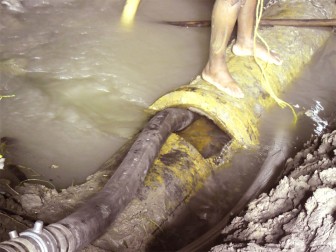By Chevy Devonish and Javon Vickerie
Residents of several wards of the city were left without water from about 10 am yesterday after a main located between Cummings and Light streets, on Church Street, ruptured around 4 pm on Saturday.
At press time, a major operation by Guyana Water Inc was still underway to staunch the flow of water. The main is a large one connected directly to the Shelter Belt. Four pumps had been employed to channel water out of the excavated area so that the pipe could be isolated but this was still not doing the job.
The Guyana Fire Service was called in around 10.20 pm to assist in the operation.
Up to press time, residents from areas such as Werk-en-Rust, Alberttown, Charlestown, Queenstown, Wortmanville and along Mandela Avenue were all reporting that they were not receiving water.
When Stabroek News contacted Timothy Austin, Public Relations Officer for GWI yesterday, he said that all efforts were being made to repair the rupture and restore a regular flow of water, but that because of the complex nature of the damage, it was proving difficult. He disclosed that GWI learned of the ruptured water main some time Saturday afternoon and began work to repair it. However, he said that engineers signalled that they would need additional time to complete the task. He said that both the Sophia and Ruimveldt Treatment Plants had to be shut down because both plants fed water into this main, and that leaving them operational would have made it even more difficult to repair. He further stated that workers from GWI hoped to complete the repairs by last night or early this morning at the latest.

Residents of the area stated that on Saturday they noticed that water was seeping up through the road and earth to the side of the road. “I see the water coming up but I thought is probably some lil pipe buss somewhere,” said one woman. She said that it was not until employees of GWI showed up the following morning that she realized the scope of the problem. “Since this morning they deh hey suh tryin fuh fix this ting, I aint know when they gon done, I aint even get to bathe me skin fuh the whole day,” said another woman.
One of the engineers on site stated that the main had ruptured simply because it was old and worn. He revealed that the pipe was part of a system of iron mains that were laid more than 50 years ago, and that years of being subjected to the pressure of continuously flowing water had placed a substantial amount of stress and strain on it, causing it to rupture.
He stated that the plan was to cut and replace a 20ft portion of iron pipe with Polyvinyl Chloride which is better than iron in many ways and can last a very long period.
It was obvious that the workers were encountering several hurdles in trying to replace the portion of damaged pipe.
When Stabroek News arrived on the site, the workers had already excavated the area around the pipe and were in the process of trying to remove the damaged portion. To get to the damaged pipe, workers had to excavate more than 3-4 feet of earth. The pipe is located on the same side of the road as the Church Street canal. As such, workers had to be careful that in getting to the pipe, they left enough earth to act as a barrier between the canal, and where the pipe was situated. However, the barrier was not perfect and water from the canal continued to find its way into the hole dug to facilitate repairs, swamping it.
GWI employees had to utilize four pumps to continually pump water out of the hole. Despite this effort though, a significant portion of the hole remained filled with water. As such, when GWI workers attempted to cut the bottom potions of the pipe, the saws, which were being used became submerged causing them to stop working. An onsite mechanic had to be continuously repairing the four or five saws that were being used at intervals. The mechanic, in an effort to dry components of the saw was observed using the high velocity air being discharged from the pumps to dry them. In addition to this obstacle, a much smaller main, which was situated parallel to the larger pipe, also had to be removed as it was blocking access to the damaged main.








